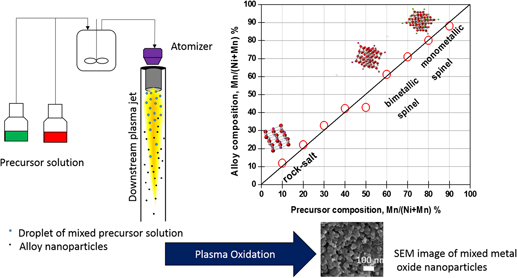Crossref Citations
This article has been cited by the following publications. This list is generated based on data provided by
Crossref.
Karmaoui, Mohamed
Amaral, J. S.
Lajaunie, Luc
Puliyalil, Harinarayanan
Tobaldi, David M.
Pullar, Robert C.
Labrincha, João A.
Arenal, Raul
and
Cvelbar, Uroš
2016.
Smallest Bimetallic CoPt3 Superparamagnetic Nanoparticles.
The Journal of Physical Chemistry Letters,
Vol. 7,
Issue. 20,
p.
4039.
Kumari, Sudesh
Ajayi, Babajide Patrick
Kumar, Bijandra
Jasinski, Jacek B.
Sunkara, Mahendra K.
and
Spurgeon, Joshua M.
2017.
A low-noble-metal W1−xIrxO3−δ water oxidation electrocatalyst for acidic media via rapid plasma synthesis.
Energy & Environmental Science,
Vol. 10,
Issue. 11,
p.
2432.
Zhao, Qing
Yan, Zhenhua
Chen, Chengcheng
and
Chen, Jun
2017.
Spinels: Controlled Preparation, Oxygen Reduction/Evolution Reaction Application, and Beyond.
Chemical Reviews,
Vol. 117,
Issue. 15,
p.
10121.
Spurgeon, Joshua M.
2018.
Converting sunlight to clean fuels: The challenges of artificial photosynthesis and progress at the Conn Center.
Vol. 1992,
Issue. ,
p.
020002.
Bazaka, K.
Baranov, O.
Cvelbar, U.
Podgornik, B.
Wang, Y.
Huang, S.
Xu, L.
Lim, J. W. M.
Levchenko, I.
and
Xu, S.
2018.
Oxygen plasmas: a sharp chisel and handy trowel for nanofabrication.
Nanoscale,
Vol. 10,
Issue. 37,
p.
17494.
Alrammouz, Rouba
Podlecki, Jean
Abboud, Pascale
Sorli, Brice
and
Habchi, Roland
2018.
A review on flexible gas sensors: From materials to devices.
Sensors and Actuators A: Physical,
Vol. 284,
Issue. ,
p.
209.
Song, Seok Hyun
Cho, Moses
Park, Inchul
Yoo, Jong‐Gyu
Ko, Kyung‐Tae
Hong, Jihyun
Kim, Jongsoon
Jung, Sung‐Kyun
Avdeev, Maxim
Ji, Sungdae
Lee, Seongsu
Bang, Joona
and
Kim, Hyungsub
2020.
High‐Voltage‐Driven Surface Structuring and Electrochemical Stabilization of Ni‐Rich Layered Cathode Materials for Li Rechargeable Batteries.
Advanced Energy Materials,
Vol. 10,
Issue. 23,
Phakatkar, Abhijit H.
Saray, Mahmoud Tamadoni
Rasul, Md Golam
Sorokina, Lioudmila V.
Ritter, Timothy G.
Shokuhfar, Tolou
and
Shahbazian-Yassar, Reza
2021.
Ultrafast Synthesis of High Entropy Oxide Nanoparticles by Flame Spray Pyrolysis.
Langmuir,
Vol. 37,
Issue. 30,
p.
9059.
Jaramillo-Cabanzo, D F
Ajayi, B P
Meduri, P
and
Sunkara, M K
2021.
One-dimensional nanomaterials in lithium-ion batteries.
Journal of Physics D: Applied Physics,
Vol. 54,
Issue. 8,
p.
083001.
Zhang, Jianan
Ji, Luyu
Gong, Junbo
and
Wang, Zhao
2022.
Facile synthesis of multiphase cobalt–iron spinel with enriched oxygen vacancies as a bifunctional oxygen electrocatalyst.
Physical Chemistry Chemical Physics,
Vol. 24,
Issue. 22,
p.
13839.
Althomali, Raed H.
and
Adeosun, Waheed A.
2023.
Wet chemically synthesized metal oxides nanoparticles, characterization and application in electrochemical energy storage: An updated review.
Synthetic Metals,
Vol. 298,
Issue. ,
p.
117424.
Tiwari, Tanu
Jalalian, Sadegh
Mendis, Chamini
and
Eskin, Dmitry
2023.
Classification of T6 Tempered 6XXX Series Aluminum Alloys Based on Machine Learning Principles.
JOM,
Vol. 75,
Issue. 11,
p.
4526.
Liu, Yueren
Xu, Likun
Xuan, Junji
Xin, Yonglei
Li, Yaxi
Duan, Tigang
and
Liu, Feng
2023.
A comparative study on Ti/IrO2–Ta2O5 anodes prepared by microwave plasma-assisted sintering and conventional thermal decomposition methods.
Journal of Materials Research and Technology,
Vol. 23,
Issue. ,
p.
1447.
Ahmadi, Masoudeh
Nouduri, Abhinav C.
Jasinski, Jacek B.
Upadhyayula, Sreedevi
Satyavolu, Jagannadh
and
Sunkara, Mahendra
2024.
Functionalized carbons and Pt/C catalysts from biomass using a plasma process.
Chemical Engineering Journal,
Vol. 498,
Issue. ,
p.
155600.
